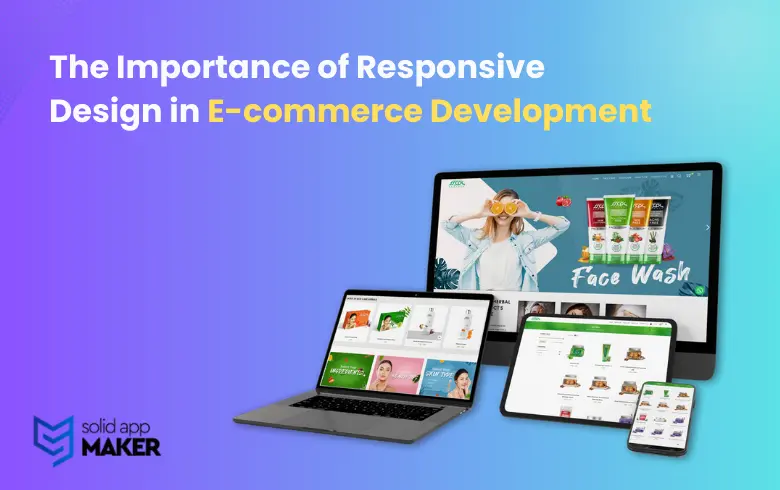In the fast-paced world of e-commerce, creating an exceptional user experience is paramount to your online success. Imagine your e-commerce website as a digital storefront; responsive design is the storefront’s adaptable and inviting facade.
In this article, we will thoroughly explore why responsive design is indispensable for your e-commerce website.
Understanding Responsive Design
Responsive design is a holistic approach to web development that ensures your website adapts seamlessly to the device used by your visitors. This adaptability is the hallmark of modern web design. Gone are the days when a single fixed design sufficed; today, it’s all about flexibility.
Responsive design ensures that your website looks and functions flawlessly whether accessed from a desktop computer, tablet, or smartphone. It’s about providing a consistent and delightful experience for all your visitors, regardless of their chosen device.
The Growth of Mobile Commerce
The rise of mobile commerce (m-commerce) is nothing short of phenomenal. More people are turning to their smartphones and tablets to shop online. If your e-commerce website is not optimized for mobile users, you’re essentially locking out a substantial chunk of your potential customers.
It’s worth noting that Google and other search engines also favor mobile-friendly websites when ranking search results. So, not only does responsive design improve the user experience, but it also enhances your website’s visibility in search results.
User Experience (UX) and Conversion Rates
User experience is the backbone of e-commerce success. Responsive design plays a pivotal role in enhancing UX. It ensures that users can seamlessly navigate your website, view products, and make purchases, regardless of the device they are using.
Think about it this way: a potential customer browsing your site on a smartphone should have the same level of convenience and satisfaction as someone accessing it from a desktop computer. When your website is user-friendly, you’re more likely to see those coveted conversion rates soar.
Incorporating responsive design into your e-commerce website development services can make all the difference.
SEO Benefits of Responsive Design
Search engine optimization (SEO) is another area where responsive design shines. Search engines like Google prefer websites that are mobile-friendly, often ranking them higher in search results. This means that responsive design not only improves the user experience but also makes your website more discoverable to potential customers.
Consider incorporating responsive design into your e-commerce website development services to achieve better SEO results.
Cross-Device Compatibility
The myriad of devices with varying screen sizes and resolutions can be a challenge for e-commerce businesses. This is where responsive design comes to the rescue. It ensures that your website functions seamlessly across different devices, eliminating the need to create separate designs for each.
By embracing responsive design, you maintain a consistent and positive experience for all your users, regardless of their chosen device.
Improved Site Performance
Website speed is crucial. Slow-loading websites frustrate users and can result in high bounce rates. Responsive design often translates to faster loading times, contributing to a better user experience and improved SEO rankings.
To optimize site performance, consider responsive design as a fundamental aspect of your e-commerce website development services.
Best Practices for Implementing Responsive Design
If you’re considering implementing responsive design, start by using tools and frameworks designed for this purpose. Regular testing and optimization are key to ensuring that your site consistently delivers a top-notch experience to all users, regardless of the device they use.
As part of your e-commerce website development services, make responsive design a priority.
Challenges and Considerations
Responsive design, like any solution, isn’t without its challenges. It requires ongoing maintenance and testing to ensure everything runs smoothly.
Understanding these factors is crucial for a successful implementation:
- Content Prioritization: When optimizing for different screen sizes, it’s essential to prioritize content. What displays prominently on a desktop may need to be reorganized or condensed on a smaller screen. Striking the right balance while maintaining the essence of your message is key.
- Navigation Complexity: Navigation menus can become more complex as responsive design caters to various devices. Creating intuitive navigation that doesn’t overwhelm users, especially on smaller screens, requires careful planning.
- Performance Optimization: Ensuring your website loads quickly across all devices can be challenging. Images, videos, and other elements must be optimized for different screen resolutions without sacrificing quality. Regular performance testing and optimization are essential.
- Testing and Quality Assurance: With a responsive design, testing becomes multi-dimensional. You must thoroughly test your website on various devices and browsers to guarantee a consistent and seamless user experience. Automated testing tools and user testing feedback can help streamline this process.
- Ongoing Maintenance: The digital landscape is ever evolving. New devices, screen sizes, and technologies emerge regularly. Your responsive design needs ongoing maintenance and updates to stay current and continue delivering an exceptional user experience.
- Budget Considerations: Implementing responsive design may require an upfront investment in terms of design, development, and testing. However, it’s an investment that pays off in the long run by enhancing user satisfaction, increasing conversions, and improving SEO rankings.
- Legacy Systems: If your e-commerce platform is built on older technology, implementing responsive design might be more complex. Legacy systems may require updates or even a complete overhaul to ensure compatibility.
Navigating these challenges and considerations is part of the journey toward a successful responsive design implementation. By addressing these factors proactively, you can harness the full potential of responsive design for your e-commerce website.
Final Words
In the world of e-commerce, responsive design isn’t merely a feature to consider; it’s an absolute necessity. As more consumers turn to mobile devices for their shopping needs, responsive design ensures your e-commerce site remains competitive, user-friendly, and search engine friendly. Hence, incorporate responsive design into your e-commerce website development services, and watch your online business thrive.

